The Big Bang Theory
The Big Bang theory is the prevailing cosmological model that describes the early development of the Universe. According to the theory, the Big Bang occurred approximately 13.798 ± 0.037 billion years ago, which is thus considered the age of the universe. At this time, the Universe was in an extremely hot and dense state and began expanding rapidly.
After the initial expansion, the Universe cooled sufficiently to allow energy to be converted into various subatomic particles, including protons, neutrons, and electrons. Though simple atomic nuclei formed within the first three minutes after the Big Bang, thousands of years passed before the first electrically neutral atoms formed.
The majority of atoms that were produced by the Big Bang are hydrogen, along with helium and traces of lithium. Giant clouds of these primordial elements later coalesced through gravity to form stars and galaxies, and the heavier elements were synthesized either within stars or during supernovae.
Weinberg's "First Three Minutes"
The Big Bang is the scientific theory that is most consistent with observations of the past and present states of the universe, and it is widely accepted within the scientific community. It offers a comprehensive explanation for a broad range of observed phenomena, including the abundance of light elements, the cosmic microwave background, large scale structure, and the Hubble diagram. The core ideas of the Big Bang—the expansion, the early hot state, the formation of light elements, and the formation of galaxies—are derived from these and other observations.
As the distance between galaxies increases today, in the past galaxies were closer together. The consequence of this is that the characteristics of the universe can be calculated in detail back in time to extreme densities and temperatures, while large particle accelerators replicate such conditions, resulting in confirmation and refinement of the details of the Big Bang model.
On the other hand, these accelerators can only probe so far into high energy regimes, and astronomers are prevented from seeing the absolute earliest moments in the universe by various cosmological horizons. The earliest instant of the Big Bang expansion is still an area of open investigation. The Big Bang theory does not provide any explanation for the initial conditions of the universe; rather, it describes and explains the general evolution of the universe going forward from that point on.
Georges Lemaître first proposed what became the Big Bang theory in what he called his "hypothesis of the primeval atom". Over time, scientists built on his initial ideas to form the modern synthesis. The framework for the Big Bang model relies on Albert Einstein's general relativity and on simplifying assumptions such as homogeneity and isotropy of space.
The governing equations were first formulated by Alexander Friedmann and similar solutions were worked on by Willem de Sitter. In 1929, Edwin Hubble discovered that the distances to far away galaxies were strongly correlated with their redshifts—an idea originally suggested by Lemaître in 1927. Hubble's observation was taken to indicate that all very distant galaxies and clusters have an apparent velocity directly away from our vantage point: the farther away, the higher the apparent velocity, regardless of direction. Assuming that we are not at the center of a giant explosion, the only remaining interpretation is that all observable regions of the universe are receding from each other.
While the scientific community was once divided between supporters of two different expanding universe theories—the Big Bang and the Steady State theory, observational confirmation of the Big Bang scenario came with the discovery of the cosmic microwave background radiation in 1964, and later when its spectrum (i.e., the amount of radiation measured at each wavelength) was found to match that of thermal radiation from a black body.
Since then, astrophysicists have incorporated observational and theoretical additions into the Big Bang model, and its parametrization as the Lambda-CDM model serves as the framework for current investigations of theoretical cosmology.

Universe is mostly light (photons ) "...it was light that then formed the dominant constituent of the universe, and ordinary matter played only the role of a negligible contaminant." Reminiscent of "Let there be light...".
Electrons and positrons created from light (pair -production ) and destroyed by annihilation at about equal rates. The pair-production threshold is 1 MeV, so the thermal energy kT=8.6 MeV was well above that.
Protons and neutrons being changed back and forth, so about equal numbers. The energy difference between neutron and proton is 1.29 MeV, so protons can be freely changed to neutrons at this temperature. Only about one baryon or 109 photons, as inferred from the 3K background and density estimates. Since the conservation of baryon number is a strong conservation principle, it is inferred that the ratio of photons to baryons is constant throughout the process of expansion.

Density 30,000,000
Free neutrons decaying into protons, so there begins to be an excess of protons over neutrons. 62% protons, 38% neutrons
???There is still plenty of energy to convert protons to neutrons (1.29 MeV), so I don't see how the judgement of relative rate is made ???

Density 400,00
Primeval fireball becomes transparent to neutrinos, so they are released. It is presumed that the universe is filled with a background of those neutrinos now in addition to the 3K microwave background of electromagnetic radiation. Since they were released earlier, the calculated temperature is lower, about 2K. The expanding matter is still opaque to light and electromagnetic radiation of all wavelengths, so they are contained.
Electron-positron annilhilation now proceeding faster than pair-production. ?? A lot faster, I would think, since 1MeV is necessary for pair-production, so that is pretty far down the population tail for photons. ??? Probably using 3kT/2 for the thermal energy. 76% protons, 24% neutrons

Time:13.82 s, Temperature: 3x109K
Below pair-production threshold, numbers of electrons and positrons rapidly decreasing. Nuclei such as 4He could form, but don't because of "deuterium bottleneck" - deuterium is not stable at this temperature. 83% protons, 17% neutrons
Big Bang Expansion and the Fundamental Forces
Modeling of the "Big Bang" expansion of the universe at earlier and earlier times has led to the use of the "Planck time" of 10-43 seconds as a proposed interval during which all the fundamental forces were unified into a single force.
Below is an attempt to illustrate the "spontaneous symmetry breaking" which is presumed to have separated the original force into the four forces which we see operating in the present, low temperature universe. Proposed energies and temperatures associated with each of the symmetry breaks are shown along with a modeling of the time elapsed in the big bang model.
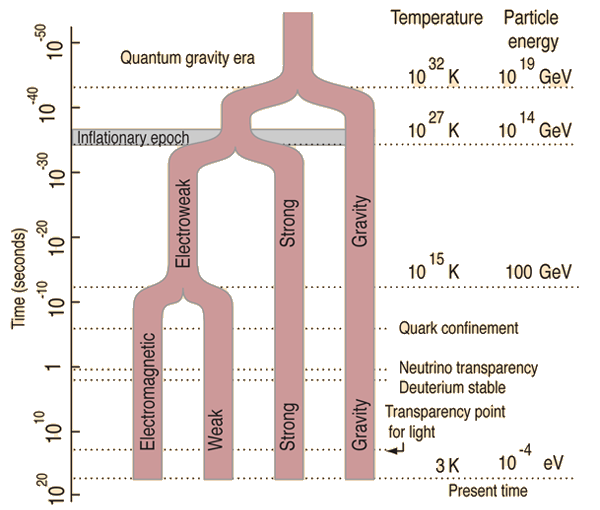
Models of Earlier Events
To model the Big Bang cosmology at earlier times than those covered in Weinberg's First Three Minutes, certain time regimes have been proposed with the types of events which would be happening at those times.
- Before 1 Planck time
- Era of 1 Planck time
- Separation of the strong force
- Inflationary period
- Quark-antiquark period
- Quark confinement
Before 1 Planck Time
Before a time classified as a Planck time, 10-43 seconds, all of the four fundamental forces are presumed to have been unified into one force. All matter, energy, space and time are presumed to have exploded outward from the original singularity. Nothing is known of this period.
It is not that we know a great deal about later periods either, it is just that we have no real coherent models of what might happen under such conditions. The electroweak unification has been supported by the discovery of the W and Z particles, and can be used as a platform for discussion of the next step, the Grand Unification Theory (GUT).
The final unification has been called a "supergrand unification theory", and becoming more popular is the designation "theory of everything" (TOE). But "theories of everything" are separated by two great leaps beyond the experiments we could ever hope to do on the Earth.
Era of 1 Planck Time
In the era around one Planck time, 10-43 seconds, it is projected by present modeling of the fundamental forces that the gravity force begins to differentiate from the other three forces. This is the first of the spontaneous symmetry breaks which lead to the four observed types of interactions in the present universe.
Looking backward, the general idea is that back beyond 1 Planck time we can make no meaningful observations within the framework of classical gravitation. One way to approach the formulation of the Planck time is presented by Hsu. One of the characteristics of a black hole is that there is an event horizon beyond which we can obtain no information - scales smaller than that are hidden from the outside world. For a given enclosed mass, this limit is on the order of

where G is the gravitational constant and c is the speed of light. But from the uncertainty principle and the DeBroglie wavelength, we can infer that the smallest scale at which we could locate the event horizon would be the Compton wavelength.

Equating L and λ, we obtain a characteristic mass called the Planck mass:

Substituting this mass back into one of the length expressions gives the Planck length

and the light travel time across this length is called the Planck time:

Keep in mind that this is a characteristic time, so its order of magnitude is what should be noted. Sometimes it is defined with the wavelength above divided by 2π, so don't worry about the number of significant digits.
Separation of the Strong Force
At a time around 10-36 seconds, present models project a separation of the strong force, one of the four fundamental forces. Before this time the forces other than gravity would be unified in what is called the grand unification. The spontaneous symmetry breaking which occurs in this era would distinguish as a separate interaction the force which would hold nuclei together in later eras.
In the 1970's. Sheldon Glashow and Howard Georgi proposed the grand unification of the strong, weak, and electromagnetic forces at energies above 1014 GeV. If the ordinary concept of thermal energy applied at such times, it would require a temperature of 1027 K for the average particle energy to be 1014 GeV.
Though the strong force is distinct from gravity and the electroweak force in this era, the energy level is still too high for the strong force to hold protons and neutrons together, so that the universe is still a "sizzling sea of quarks".
Inflationary Period
Triggered by the symmetry breaking that separates off the strong force, models suggest an extraordinary inflationary phase in the era 10-36 seconds to 10-32 seconds. More expansion is presumed to have occurred in this instant than in the entire period ( 14 billion years?) since.
The inflationary epoch may have expanded the universe by 1020 or 1030 in this incredibly brief time. The inflationary hypothesis offers a way to deal with the horizon problem and the flatness problem of cosmological models.
|  |
Lemonick and Nash in a popular article for Time describe inflation as an "amendment to the original Big Bang" as follows: "when the universe was less than a billionth of a billionth of a billionth of a second old, it briefly went through a period of superchanged expansion, ballooning from the size of a proton to the size of a grapegruit (and thus expanding at many, many times the speed of light). Then the expansion slowed to a much more stately pace. Improbable as the theory sounds, it has held up in every observation astronomers have managed to make."
Quark-antiquark Period
As the inflationary period ends, the universe consists mostly of energy in the form of photon , and those particles which exist cannot bind into larger stable particles because of the enormous energy density. They would exist as a collection of quarks and antiquarks along with their exchange particles, a state which has been described as a "sizzling sea of quarks". This time period is estimated at 10-32 seconds to 10-5 seconds. During this period the electromagnetic and weak forces undergo the final symmetry break, ending the electroweak unification at about 10-12 seconds.
Quark Confinement
When the expansion of the "primordial fireball" had cooled it to 1013 Kelvin, a time modeled to be about 10-6 seconds, the collision energies had dropped to about 1 GeV and quarks could finally hang onto each other to form individual protons and neutrons (and presumably other baryons.) At this time, all the kinds of particles which are a part of the present universe were in existence, even though the temperature was still much too high for the formation of nuclei. At this point we can join the standard "big bang" model as outlined by Steven Weinberg in The First Three Minutes.
Inflationary Period in Big Bang
Partly in response to the problems in cosmological models known as the "flatness problem" and the "horizon problem", Alan Guth proposed a period of extraordinary inflation at an early stage of the "Big Bang" expansion of the universe.

The Wilkinson Microwave Anisotropy Probe (WMAP)
The WMAP mission has provided the first detailed full-sky map of the microwave background radiation in the universe. The map produced is characterized as a map of the effective temperature of the microwave background radiation as depicted below. This is a synopsis of the description of the mission from the WMAP mission report on the NASA website. The illustrations are NASA graphics.
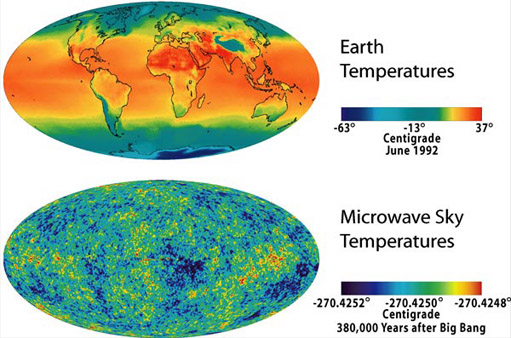
Note that the temperature variation on the Earth covers about 100°C while those measured by WMAP range only over about 0.0004 °C, a smaller range by a factor of a quarter of a million.
The wavelengths of radiation detected by WMAP were in the microwave region of the electromagnetic spectrum as depicted in the NASA graphic below.

The synopsis of the implications of WMAP as summarized in the mission report includes the following quote from the WMAP site:
- Universe is 13.7 billion years old, with a margin of error close to 1%.
- First stars ignited 200 million years after the Big Bang.
- Light in WMAP picture is from 379,000 years after the Big Bang.
- Content of the Universe:
- 4% Atoms, 23% Cold Dark Matter, 73% Dark Energy.
- The data places new constraints on the Dark Energy. It seems more like a "cosmological constant" than a negative-pressure energy field called "quintessence". But quintessence is not ruled out.
- Fast moving neutrinos do not play any major role in the evolution of structure in the universe. They would have prevented the early clumping of gas in the universe, delaying the emergence of the first stars, in conflict with the new WMAP data.
- Expansion rate (Hubble constant) value: H0 = 71 km/sec/Mpc (with a margin of error of about 5%.
- New evidence for Inflation (in polarized signal).
- For the model which fits our data, the Universe will expand forever. The density parameter Ω is measured to be 1.02 +/- 0.02 . (The nature of the dark energy is still a mystery. If it changes with time, or if other unknown and unexpected things happen in the universe, this conclusion could change.)
The positioning of the WMAP satellite made use of the Lagrange point L2 which permitted it to be kept in place with a minimum expenditure of fuel and always keep its sensors pointed away from both the Earth and
Role of 3K in Cosmology
The 3K background provides foundational evidence for cosmological models. The 3K background implies about 5.5 x 105 photons/liter. This is based on the radiation energy density and the average energy per photon at this temperature. The range of estimates for baryon density is from twice critical density at 6 x 10-3/liter to the low end estimate of the visible galaxy, 3 x 10-5/liter.
This gives a range of 1 x 108 to 2 x 1010 photons/baryon. It is this estimate of the number of photons per baryon which was crucial in calculations of the big bang. In the modeling of nucleosynthesis in the big bang, including the hydrogen/helium ratio, the relative population of baryons and photons agreed with observations.
When the trace quantities of D, 3He, and 7Li are examined and made a part of the big bang model, the ratio of baryons to photons is constrained more tightly. The Particle Data Group gives the baryon/photon ratio η as 2.6 x 10-10 < η < 6.3 x 10-10 baryons/photon.
Big Bang Nucleosynthesis
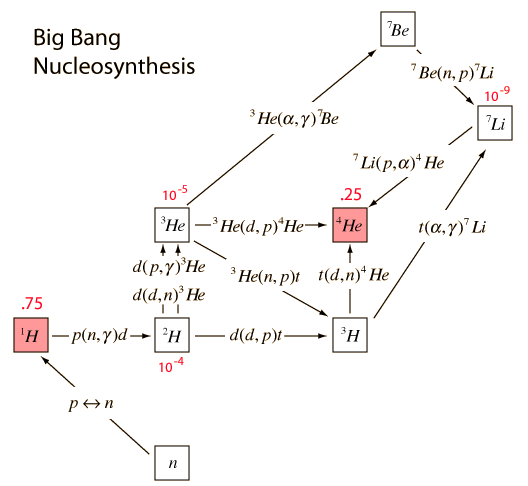
The modeling of the early universe by the standard big bang model gives a scenario that involves twelve nuclear interactions that led to the present cosmic abundances of elements outside the stars. The vast majority of the mass of ordinary matter in the universe ishydrogen and helium, remaining from the early stages of the universe. The illustration above gives nominal abundances of the current constituents. These abundances are model dependent and subject to revision.
Beryllium-7 is an isotope that is produced in this process, but is not a part of the cosmic abundances because it is radioactive with half-life 53.28 days, decaying to 7Li. Neutrons are not part of the background elements because free neutrons decay with half-life 10.3 minutes. The other constituent of the reactions is tritium, 3H, which has a half-life of 12.32 years.
Hydrogen-Helium Abundance
Hydrogen and helium account for nearly all the nuclear matter in today's universe. This is consistent with the standard or "big bang" model. The process of forming the hydrogen and helium and other trace constituents is often called "big bang nucleosynthesis". Schramm's figures for relative abundances indicate that helium is about 25% by mass and hydrogen about 73% with all other elements constituting less than 2%. Carroll & Ostlie give 23 to 24% helium.
There is a window of uncertainty, but it is clear that hydrogen and helium make up 98% plus of the ordinary matter in the universe. This high percentage of helium argues strongly for the big bang model, since other models gave very small percentages of helium. Since there is no known process which significantly changes this H/He ratio, it is taken to be the ratio which existed at the time when the deuteron became stable in the expansion of the universe.
This ratio is significant as a test of cosmological models since it will be affected by the time period from the time when the temperature dropped below that necessary to produce neutrons from protons to the time when the deuteron became stable, halting the decay of the free neutrons.
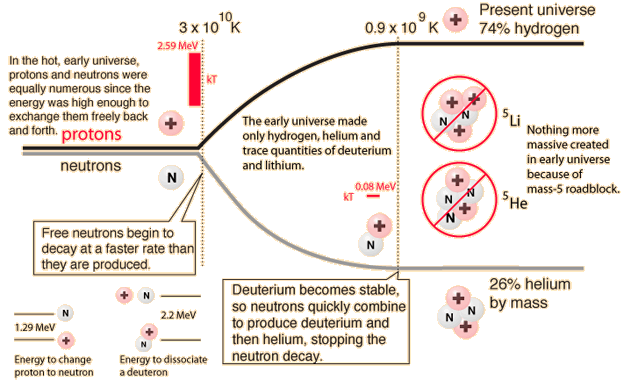
Basically , the hydrogen-helium abundance helps us to model the expansion rate of the early universe. If it had been faster, there would be more neutrons and more helium. If it had been slower, more of the free neutrons would have decayed before the deuterium stability point and there would be less helium.
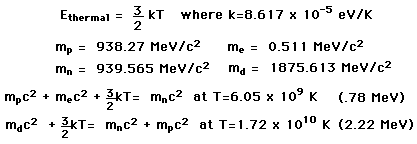
 |
The modeling of the production of helium and the hydrogen-helium ratio also makes predictions about other nuclear species, particularly 7Li, 2H(deuterium) and 3He. These observed abundances simultaneously fit the big bang model within a narrow range.
The shaded areas represent measurements from regions which have a very small abundance of heavy elements, so that they seem to be good samples of primordial abundances. Besides being a sensitive test of the big bang model, the abundance of helium also correlates best with three types of neutrinos, rather than two or four. The presence of another neutrino species, and thus another round of leptons would give a higher helium abundance by about a percent.
The ratio of the number of baryons per photon was one of the contributions of the discovery of the 3K background radiation. Those measurements permitted a calculation of the photon energy density in the universe and the range of estimates for baryon density gave a baryon/photon ration of about 10-9.
Data from Boesgaard, A. M. and Steigman, G., "Big Bang nucleasynthesis: Theories and Observations", Ann. Rev. Astron. and Astrophys. 23, 319 (1985).
|
The Age of the Universe ? Is 13.77 x 109 years.
How old is the universe? This provocative question will be addressed only by describing the models we have of the expanding universe and the Big Bang process. If we could take the presently observed expansion and project backward to the beginning of that process, then it would seem reasonable to call that the age of the universe.
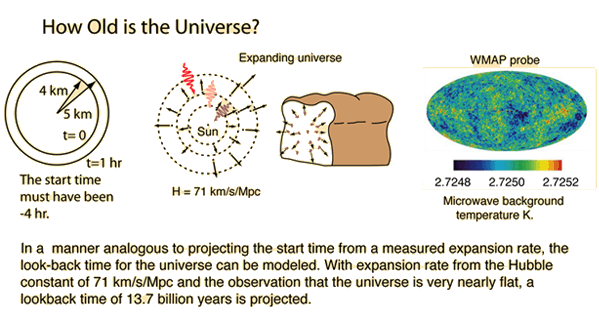
If we were dealing with a simple expansion as suggested at left in the illustration, and could measure the expansion as a function of time, then it might be straightforward to calculate the time of origin of the expansion. But our time span of observation is so brief compared to the process as a whole that we must draw our conclusions from an almost instantaneous view. We can see clear evidence of expansion from the Doppler red shift, and the fact that more distant stars are redshifted more.
The Hubble law and the value of the Hubble constant give us a parameter that we can translate into an expansion time but there are other factors involved. Because of the uncertainties in distance measurement to other galaxies, there have been considerable uncertainties about the value of the Hubble constant.
Recent measurements of the cosmic background radiation by the COBE and WMAP satellites have provided values of the Hubble constant which are much more precise.
Even with the a known value for the Hubble constant, the value projected for the age of the universe is model dependent. Much evidence suggests that the universe is very nearly "flat", i.e., it is expanding at just about the right rate to expand indefinitely. Perfectly flat would mean that it would asymptotically approach a zero expansion rate, and not collapse back. A flat universe, termed an "Einstein-de Sitter universe" requires a critical mass density. We presume that we have very close to that critical mass density, but it is much more than the mass density we see, hence the presumption of "dark matter" to make up the bulk of the critical mass.
With the presumption of a flat universe, we can project an expansion time by making use of the current cosmic background temperature and the critical mass density of the universe. For a Hubble constant of 71 km/s/Mpc the critical density is 5.33 GeV/m3.
When this is substituted into the equation for expansion time you get 13.77 x 109 years.
Dark matter
During the 1970s and 1980s, various observations showed that there is not sufficient visible matter in the Universe to account for the apparent strength of gravitational forces within and between galaxies.
This led to the idea that up to 90% of the matter in the Universe is dark matter that does not emit light or interact with normal baryonic matter. In addition, the assumption that the Universe is mostly normal matter led to predictions that were strongly inconsistent with observations.
In particular, the Universe today is far more lumpy and contains far less deuterium than can be accounted for without dark matter. While dark matter has always been controversial, it is inferred by various observations: the anisotropies in the CMB, galaxy cluster velocity dispersions, large-scale structure distributions, gravitational lensing studies, and X-ray measurements of galaxy clusters.This led to the idea that up to 90% of the matter in the Universe is dark matter that does not emit light or interact with normal baryonic matter. In addition, the assumption that the Universe is mostly normal matter led to predictions that were strongly inconsistent with observations.
Indirect evidence for dark matter comes from its gravitational influence on other matter, as no dark matter particles have been observed in laboratories. Many particle physics candidates for dark matter have been proposed, and several projects to detect them directly are underway.


Sem comentários:
Enviar um comentário